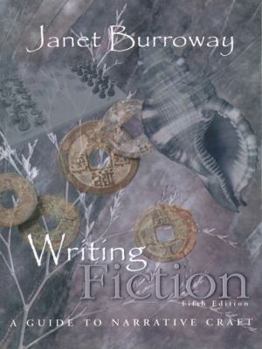Writing Fiction: A Guide to Narrative Craft (5th Edition)
Select Format
Select Condition 
Book Overview
More than 250,000 copies sold A creative writer's shelf should hold at least three essential books: a dictionary, a style guide, and Writing Fiction. Janet Burroway's best-selling classic is the most... This description may be from another edition of this product.
Format:Paperback
Language:English
ISBN:0321026896
ISBN13:9780321026897
Release Date:July 1999
Publisher:Addison-Wesley
Length:384 Pages
Weight:1.22 lbs.
Dimensions:9.5" x 0.8" x 6.5"
Customer Reviews
3 ratings
Best book on the craft of writing ever written!
Published by Thriftbooks.com User , 27 years ago
I teach writing in the UCLA Writer's Program (online) and always recommend this and "What If" by Ann Bernays and Pam Painter. Burroway's book is absolutely the best book on the craft of writing I've ever found. Anybody who aims to write well would do him- or herself a huge favor by buying this book. I've been drawn to it over and over when writing my own books, "The Death of Tarpons" (novel), "Monday's Meal" (Collection of short stories; and my forthcoming "Over Easy" from Random House and Ballantine Books (1999). I'm now involved in writing screenplays and the techniques Ms. Burroway covers in her book cover that form as well. I think giving it 5 stars is not enough and if it were possible to award ten stars, I would, enthusiastically. If you only buy one book on writing in your lifetime, make it this one!
Best nuts-and-bolts book on creative writing
Published by Thriftbooks.com User , 27 years ago
For my money, this is the best book available about creative narrative writing. Burroway's book is used as a text for short story and novel writing. The chapter "Showing and Telling" alone is worth the price of the book. Other areas covered by chapters in the book are as follows:Story form and structureCharacterization: Two chapters that cover every thing from dialogue to detailing the five ways to develop a character: authorial interpretation, appearance, action, speech, and thoughtSetting and atmospherePoint of ViewLiterary devices such as symbol, metaphor, etc.ThemeRevision: This chapter is the weakest because it discusses revision in general, not giving specific problems that plague manuscripts. The most prevalent flaws are discussed in the book, but I think it would be helpful to list them in this chapter and give page numbers where the technique is discussed.I have read over twenty books pertaining to creative writing, but this one is better than all the rest. What I like best are the numerous stories that are at the end of each chapter illustrating the points discussed in that section. Each chapter concludes with questions to guide one's study.In my reading of books about fiction writing, I have found numerous references to this book which indicates to me the quality of this book to other writers.If you can only afford one book, get this one. I don't think you will be disappointed if you are serious about your fiction.
All arouund introdcution to the craft of fiction
Published by Thriftbooks.com User , 28 years ago
Main Topics: A. The writing process - What it takes to get started. B. Story form and structure - The basics in a nutshell .....Conflict, Crisis & Resolution, Plot C. The importance of details, voice, rhythm D. Characterization .....Individual, Typical and Universal .....Well rounded characters (vs flat) .....Direct representation .......speech, action, thought and conflict E. Creating atmosphere - scene and summary F. Point of View issues, first, second and third person. G. Metaphors, Similies, Symbols and Allegories H. Theme - Ideas, morality and more on details I. Revisions Of Special Interest: Not only does Burroway cover all the major important topics clearly, she has extensive examples from a wide variety of high quality short story writers to illustrate her points. Undoubtedly one of the best books to use when getting started. Significant quotes: On Crisis and resolution: Fortunately, The necessary features of the story form are fewer than those of a face. They are conflict, crisis and resolution. Conflict is the fist encountered and the fundamental element of fiction, necessary because in literature, only trouble is interesting. On the distinction between story and plot: A story is a series of events recorded in their chronological order. A plot is a series of events deliberatly arranged so as to reveal their dramatic, thematic and emotional significance. On details: A detail is definite and concrete when it appeals to the senses. It should be seen, heard, smelled, tasted and touched...particular details--these are the life of fiction.






